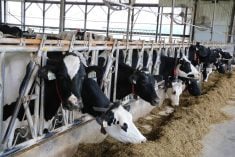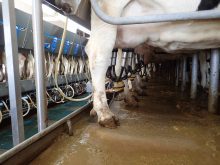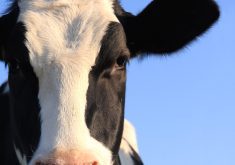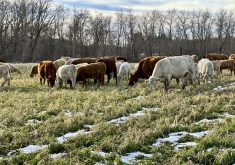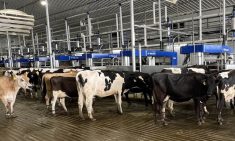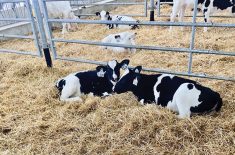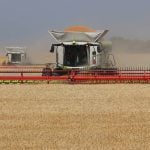Glacier FarmMedia – Cow comfort is king in the battle against lameness.
That’s the opinion of Mark Gerber of Zinpro dairy technical sales, and a master hoof trimmer.
“If that cow doesn’t have a comfortable bed 12 hours a day, we’re going to have problems,” Gerber said. “We really have to focus on cow comfort. Are our stalls set right? Is the bedding right? Are the surfaces? Are we getting maximum yield?”
Read Also

Beekeepers want financial protection against tropi mite
Tropilaelaps (tropi) mites haven’t landed in Canada yet; beekeepers want to know they’ll get federal financial help if the deadly bee parasite ever does
Why it matters: Cow comfort, trimming and foot bathing are critical for lameness prevention in dairy cows.
It’s difficult for producers to accurately identify a cow as lame when locomotion scoring occurs in a busy pen or part of the farm, said Dr. David Kelton, professor emeritus at the Ontario Veterinary College.
Aspects unrelated to lameness can affect the way a cow steps and carries her head and back, he added, including injury or a full udder.
Genetic disorders and hoof lesions play a part, he noted, but accurate herd lameness assessments require careful observation of cow movement.

Infectious causes
Cargill Animal Nutrition dairy technical specialist Mike Groen agreed with Gerber, saying nutrition increases cow health and farm success, but cow comfort is the primary focus with which to combat lameness.
“If you’re thinking about infectious or metabolic diseases — so, metritis and mastitis, milk fever, ketosis — barn design environment, flooring surface, the amount of time the cows have been on their feet, that all relates to lameness,” said Groen.
He said nutrition can also affect lameness. For example, acidosis can lower rumen pH, leading to rumen microbe death and triggering a release of endotoxins through inflammation, sparking lameness.
But cow environment is the first line of attack.
Gerber said he would like to see more aggressive action from producers to address strawberry foot (digital dermatitis) in heifers and dry cows.
Nutritional products are available for non-lactating diets to help prevent digital dermatitis. Gerber said studies show these can reduce the occurrence by 60 per cent.
“It has to be in those diets, if you talk to your feed manufacturer, a minimum of 60 days before you start seeing lesions and they’re walking on their toes.”
In herds with 20 to 30 per cent or higher incidence of digital dermatitis, Gerber advised two weeks of daily foot shock before phasing in a two- or three-day-a-week schedule to clean it up.
Over 30 days, that should address the problem, but without continuous maintenance, it will return because large lesions penetrate deeply into the dermis.
Foot baths
Gerber’s ideal dairy cow foot bath is 12 feet long, approximately three feet wide and six inches deep to ensure complete coverage from the coronary band down, especially on the hind legs where digital dermatitis is most prevalent.
“Based on the volume of water litres of that foot bath, how big it is, that’s going to tell you how many cows you’re going to be able to get through (before refreshing),” he explained.
Gerber uses two to three per cent formaldehyde, which requires extra care, but he suggested five per cent non-acidified copper or two to three per cent acidified copper as alternatives. Regular calibration is encouraged because the chemical is deactivated by cow dung.
Hoof trimming
Christian Nagel, owner of Nagel Hoof Care, said incorporating indoor hoof trimming areas in new barn builds or retrofits will attract hoof trimmers and improve cow comfort compared to all-weather trimming.
Herd management styles affect trimming schedules, as does stocking density and bedding. Nagel avoids trimming during cow transition periods unless absolutely necessary.
“She’s losing weight, she’s losing body condition, that fat pad at the bottom of her foot is getting thinner,” Nagel said. “We just run more risk of potentially causing issues if we’re just doing maintenance trims (then).”
Bedding and flooring
Housing environment plays a significant role in cow comfort and the incidence of lameness and abnormal locomotion.
Kelton said free stalls and tie stalls have similar lameness levels, according to provincial and national data.
“Consistently, probably the least amount of lameness issues we see are in bedded pack barns,” he said.
Nagel agreed, suggesting bedded pack barns rank highest, followed by sand-bedded free stalls. Gerber said the U.S. ranks sand first, recycled dried manure solids second and mattresses third.
Built to withstand cow wear and tear, mattress fabrics tend to be coarse, especially when new, and can cause rug-like burns on hocks and knees.
“Mattresses are a good base, but they need sufficient bedding on top to minimize that friction,” Gerber said.
He suggested four to six inches of bedding will do, but keeping it under the cows requires constant maintenance.
Flooring maintenance and timely regrooving can reduce white line incidents, added Groen.
– Diana Martin is a reporter for Farmtario.



